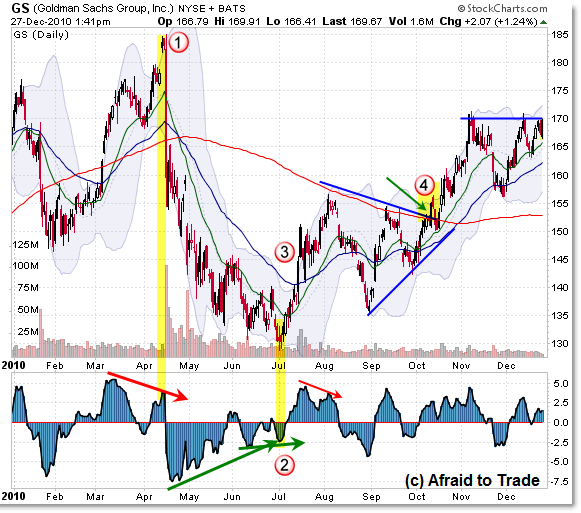Divergences and Breakout Trading Lessons in GS 2010
Goldman Sachs has been a wild ride for both investors and traders this year, despite being a leading financial company.
As per usual practice, the chart gives us excellent examples of trading tactics we can use as a reference for the future.
Let’s take a look specifically at Two Divergences and the resulting Two Breakouts in Goldman Sachs (GS) shares and the lessons we can learn from them.

Volatility withstanding, Goldman Sachs shares appear poised to end 2010 right where they began – at the $165/$170 region. Though the annual range spanned $55 points, GS ended where it began.
The numbers on the chart don’t refer to Elliott Waves, but rather call your attention to the following points:
1. Negative Divergence at the Highs
I’m a big fan of trading divergences, and when a divergence sets up, it’s a warning sign of caution, but not necessarily a “panic/exit” signal.
In this case however, it was one of the “panic/exit” situations wherein the new price high was NOT confirmed with a new high in the 3/10 Momentum oscillator (or volume if you look closely).
Now, perhaps this example isn’t fair, as the big plunge in price – about the same time as the BP Oil Spill – resulted from an announcement of a pending lawsuit against Goldman Sachs which was later resolved. Still, the fall-out cost shareholders dearly.
The orderly sell-off – at least from May to July – resulted in one of my favorite patterns: A MULTI-swing positive divergence.
2. Multi-swing Positive Divergence / Rounded Reversal Pattern
I posted on this at the time, and it’s another example of how divergences often precede price/trend reversals, but you can’t pinpoint the exact low UNTIL price takes out a prior high or breaks above a key EMA – like the 50 day EMA.
This shows you why you DON’T trade divergences (fight a prevailing trend) in isolation – and how divergences are CONDITIONS and not trade TRIGGERS (as we’ll soon see).
Look closely at the 3/10 momentum oscillator and the multiple higher lows that corresponded with a series of LOWER price lows in the stock.
That – again – warns short-sellers that the fuel is running out and a reversal is developing, only we need something else to trigger us in.
Divergences can be helpful “take profit” signals, but not necessarily “get long” signals, as you see that price inched its way lower despite the official new momentum low forming in late April. Price bottomed at the start of July.
While divergences are frequently leading signals of trend reversals, it’s often best from a trading standpoint to wait for a trigger….
3. BREAKOUT Through the 50 day EMA
In mid-July, we got the official reversal signal in the form of a surge higher in price which broke through the falling 50 day EMA at the $140 price zone.
Notice the volume surge that accompanied the breakout (look close).
Momentum precedes price, so a surge in momentum – after a lengthy positive divergence situation – signaled that odds now favored HIGHER prices yet to come, which continued in an uptrend to the present day.
Pay attention to the OFFICIAL signal which (should have) compelled those short to take profits/exit and sidelined/patient longs to dip their feet back in and buy shares on the breakout. For those reasons, it triggered another favorite pattern of mine – the “Popped Stops.”
4. Triangle Breakout and 200 day SMA
While the other three references I highlighted had additional components with them, point 4 is just a simple Breakout above a Simple Symmetrical Triangle Pattern.
The trigger is of course the official price breakout above the upper (or lower) trendline – in this case at $153, or $155 to throw-in a reference number.
Perhaps digging a little deeper than the simple triangle, notice that price found three points of overhead resistance (targets) prior to the surge above both the triangle trendline and – of course – 200 day SMA.
A lot of traders who don’t really use technical analysis will monitor the 200 day SMA to define whether price is in an “uptrend” (if above) or “down trend” (if under).
While that’s simplistic, it works for some traders and they act – positioning or repositioning in accordance with a breakthrough of the key average.
Anyway, the point is that a price breakout – buyers pushing through confluence resistance – was yet another swing/intermediate trade in the context of a rising trend.
A price breakthrough of a key level is both a “cover shorts/short squeeze” and “get long” signal for many traders.
While there are many lessons to learn, I thought it would be neat to focus on these four points – two divergences and two breakouts – as a starting point for reference when you see similar situations occur in stocks in the future.
Corey Rosenbloom, CMT
Afraid to Trade.com
Follow Corey on Twitter: http://twitter.com/afraidtotrade

I posted a comment, but seems it didnt appear here 🙁
I was wondering how will the current dovergence will play out here? GS sure made attempts to go beyond 170 but failed, while the divergences are formed on MACD. Do you think it will play out ? short ?
is there a double top now?
Your blog is very important for me and i really got very useful and appropriate thing from your blog. I appreciate your blog and i would like to thanks for sharing.
free trading tips